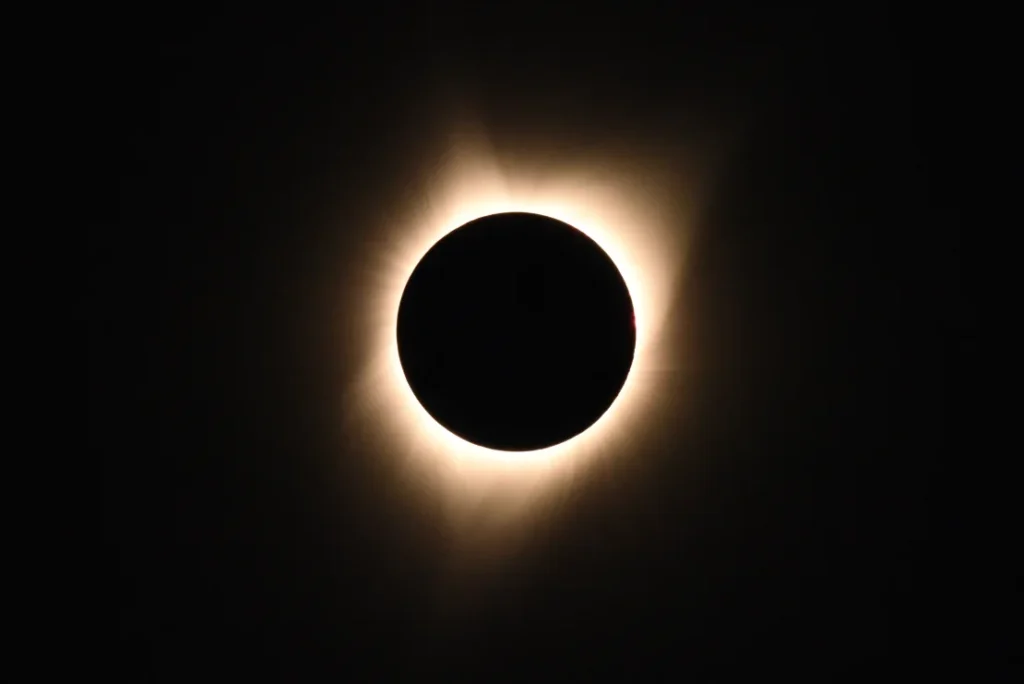This year, on April 8, 2024, a total solar eclipse is expected to sweep across North America, casting its shadow over the United States, Mexico, and Canada in an amazing celestial event.
What is a Total Solar Eclipse?
During a total solar eclipse, the Moon navigates to a position between the Sun and Earth, completely obscuring the Sun’s surface. Observers located within the path of totality, where the Moon fully covers the Sun, will witness this remarkable event. The sky will appear dark as if it were dawn or dusk. Subject to favorable weather conditions, individuals along this path will have the opportunity to view the Sun’s corona, its outer atmosphere typically hidden by the sun’s intense brightness.

Where and When?
The total solar eclipse occurring on Monday, April 8, 2024, will traverse North America, passing over Mexico, the United States, and Canada. The event is expected to begin over the South Pacific Ocean. If weather conditions permit, totality will first be witnessed in continental North America along Mexico’s Pacific coast around 11:07 a.m. PDT.
The eclipse’s trajectory extends from Mexico to the United States, passing through Texas, Oklahoma, Arkansas, Missouri, Illinois, Kentucky, Indiana, Ohio, Pennsylvania, New York, Vermont, New Hampshire and Maine. Parts of Tennessee and Michigan will also witness totality. Crossing into Canada in Southern Ontario before traversing Quebec, New Brunswick, and Prince Edward Island towards Cape Breton. The celestial event will conclude on the Atlantic coast of Newfoundland in Canada at 5:16 p.m. NDT.
| Location | Partial Begins | Totality Begins | Maximum | Totality Ends | Partial Ends |
|---|---|---|---|---|---|
| Dallas, Texas | 12:23 p.m. CDT | 1:40 p.m. CDT | 1:42 p.m. CDT | 1:44 p.m. CDT | 3:02 p.m. CDT |
| Idabel, Oklahoma | 12:28 p.m. CDT | 1:45 p.m. CDT | 1:47 p.m. CDT | 1:49 p.m. CDT | 3:06 p.m. CDT |
| Little Rock, Arkansas | 12:33 p.m. CDT | 1:51 p.m. CDT | 1:52 p.m. CDT | 1:54 p.m. CDT | 3:11 p.m. CDT |
| Poplar Bluff, Missouri | 12:39 p.m. CDT | 1:56 p.m. CDT | 1:56 p.m. CDT | 2:00 p.m. CDT | 3:15 p.m. CDT |
| Paducah, Kentucky | 12:42 p.m. CDT | 2:00 p.m. CDT | 2:01 p.m. CDT | 2:02 p.m. CDT | 3:18 p.m. CDT |
| Carbondale, Illinois | 12:42 p.m. CDT | 1:59 p.m. CDT | 2:01 p.m. CDT | 2:03 p.m. CDT | 3:18 p.m. CDT |
| Evansville, Indiana | 12:45 p.m. CDT | 2:02 p.m. CDT | 2:04 p.m. CDT | 2:05 p.m. CDT | 3:20 p.m. CDT |
| Cleveland, Ohio | 1:59 p.m. EDT | 3:13 p.m. EDT | 3:15 p.m. EDT | 3:17 p.m. EDT | 4:29 p.m. EDT |
| Erie, Pennsylvania | 2:02 p.m. EDT | 3:16 p.m. EDT | 3:18 p.m. EDT | 3:20 p.m. EDT | 4:30 p.m. EDT |
| Buffalo, New York | 2:04 p.m. EDT | 3:18 p.m. EDT | 3:20 p.m. EDT | 3:22 p.m. EDT | 4:32 p.m. EDT |
| Burlington, Vermont | 2:14 p.m. EDT | 3:26 p.m. EDT | 3:27 p.m. EDT | 3:29 p.m. EDT | 4:37 p.m. EDT |
| Lancaster, New Hampshire | 2:16 p.m. EDT | 3:27 p.m. EDT | 3:29 p.m. EDT | 3:30 p.m. EDT | 4:38 p.m. EDT |
| Caribou, Maine | 2:22 p.m. EDT | 3:32 p.m. EDT | 3:33 p.m. EDT | 3:34 p.m. EDT | 4:40 p.m. EDT |
How to Watch Live?
Watch live telecast by NASA on this link: Solar Eclipse by NASA+
What to expect before the eclipse?
To witness a total solar eclipse, you must be within the path of totality, typically less than 150 miles wide.
If you already live somewhere the eclipse can be seen, you don’t need to move about to observe the phenomena. However, if that is not the case, please make sure to travel accordingly beforehand.
After determining your location, select a specific viewing spot for the eclipse. When deciding on the location, please ensure you are also considering the key factor of weather around the location during the eclipse.
Any Safety precautions?
It is not advisable to look directly at a partially or uneclipsed Sun, without having any proper eyewear protection. The only odd brief moments where one can consider looking directly at a solar eclipse is when the Moon completely covers the sun. During a total solar eclipse, only during the moments of totality i.e. when the Moon completely covers the Sun, one can look at a solar eclipse without eye protection.

